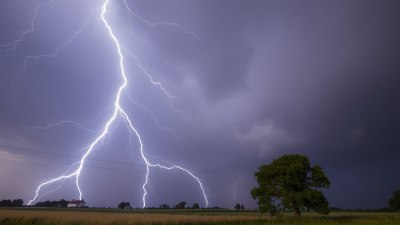Why the Weather Is the Ultimate Ghoster — Here One Minute, Gone the Next
Explore the unpredictable nature of weather phenomena and how it can vanish just as quickly as it appears.

The weather has a unique ability to change in the blink of an eye, often leaving us both fascinated and frustrated. In this article, we delve into the reasons why weather is the ultimate ghoster, appearing one moment and disappearing the next. From the science behind weather systems to the phenomenon of volatile conditions, we will explore the unpredictable nature of our atmosphere.
Understanding Weather Fluctuations
Weather fluctuation refers to the short-term changes in the atmospheric conditions in a particular area. These conditions may vary significantly based on numerous factors including temperature, humidity, and air pressure. It’s essential to understand that weather systems are dynamic, meaning they are constantly evolving due to interactions between different elements.
One of the significant influences on weather changes is the movement of high and low-pressure systems. High-pressure areas typically indicate fair weather conditions, while low-pressure areas often bring storms and precipitation. These systems can move quickly across regions, leading to sudden weather changes that seem to come from nowhere.
The Role of Atmospheric Conditions
The atmosphere is a complex layer of gases surrounding the Earth. This layer is divided into different regions, each with distinct temperatures and pressures that influence weather changes. When warm, moist air meets cold, dry air, it creates instability in the atmosphere, which often results in abrupt weather changes like thunderstorms or rapid temperature drops.
One prominent example of this is the phenomenon known as a cold front. It occurs when a mass of cold air pushes into a region occupied by warmer air, leading to swift changes in weather conditions. This transition can manifest as sudden rain or temperature drops, further emphasizing the weather's ghosting nature.
The Influence of Geography
Your geographical location significantly impacts weather patterns and fluctuations. Areas near large bodies of water, like oceans and lakes, often experience more humidity, leading to sudden rain showers. Conversely, desert regions typically have stable weather with minimal precipitation. Mountains also play a crucial role; they can block or redirect airflow, causing varying weather conditions at different elevations.
For instance, regions situated in the rain shadow of a mountain will experience dry weather while the opposite side may be drenched in rain. Such phenomena illustrate how localized geography contributes to the unpredictable behavior of weather.
Seasonal Changes
Seasonal transitions also contribute to unpredictable weather behaviors. As the Earth tilts on its axis throughout the year, different regions receive varying degrees of sunlight, resulting in seasonal weather changes. Spring and autumn are particularly notorious for their unpredictable conditions, often fluctuating between mild and extreme temperatures.
During these transitional seasons, cold and warm air masses frequently clash, producing unpredictable weather and enhancing the ghosting effect of the weather phenomenon. Whether experiencing unseasonably warm days in winter or chilly nights in summer, these swings keep us guessing about what the next day may hold.
The Impact of Climate Change
In recent years, climate change has significantly impacted weather patterns globally. Rising temperatures lead to increased evaporation levels, resulting in more intense storms or prolonged periods of drought. These shifts can create chaotic weather predictions, making it harder to anticipate conditions accurately.
Extreme weather events are increasingly common thanks to climate change, and the collective unpredictability can cause events that seem ‘ghosted’ right when you expect a consistent pattern. Unprecedented winter storms can hit just as suddenly as a summer heatwave appears, showcasing how climate change contributes to the ghosting effect of weather.
Technology and Weather Forecasting
Despite advancements in technology and forecasting models, predicting weather can sometimes feel like an impossible task. Meteorologists rely on various tools, including satellites, radar, and numerical weather prediction models. However, the complexity of atmospheric processes means unpredictability will always remain part of weather forecasting.
Weather apps and services often provide real-time updates, but they can only predict the future based on current data. Sudden changes can occur in minutes, leaving many caught off guard. The dynamic nature of weather means there will always be instances where forecasts seem inaccurate, reinforcing its reputation as the ultimate ghoster.
Psychological Impacts of Weather Changes
The psychological effects of sudden weather changes can be profound, often impacting our mood and behavior. Studies have shown that unexpected weather patterns can affect people's emotions, from sunshine to heavy rain. The unpredictability of the weather can trigger anxiety, especially for those planning outdoor activities or events.
Many people find they have more energy and positivity on sunny days while gloomier weather can dampen spirits. The ghosting nature of weather can leave us longing for stability; the constant flux can lead to frustration when a sunny day turns into a rainstorm without warning.
In conclusion, the weather's ability to disappear and reappear is a phenomenon driven by various atmospheric conditions, geographic influences, seasonal changes, and climate shifts. No matter how advanced our technology becomes, the inherent unpredictability of weather serves as a reminder of the natural world's complexity. By embracing this unpredictability, we can learn to appreciate the beauty and chaos that comes when weather plays its ghosting game with us. So the next time a rainstorm catches you off guard, remember, it's just another act in the ultimate ghosting performance that is the weather.











